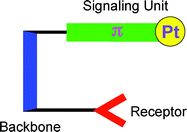Synthesis and spectroscopic properties of modular platinum(II) terpyridine phosphorescent pockets†
Abstract
A modular design approach has been utilized to develop molecular ‘pockets’ featuring three integrated components, namely a phosphorescent Pt(II)-π(organic) moiety, a suitable receptor group, and a rigid, conjugated connecting backbone, and the cavities therein are examined by


 Please wait while we load your content...
Please wait while we load your content...